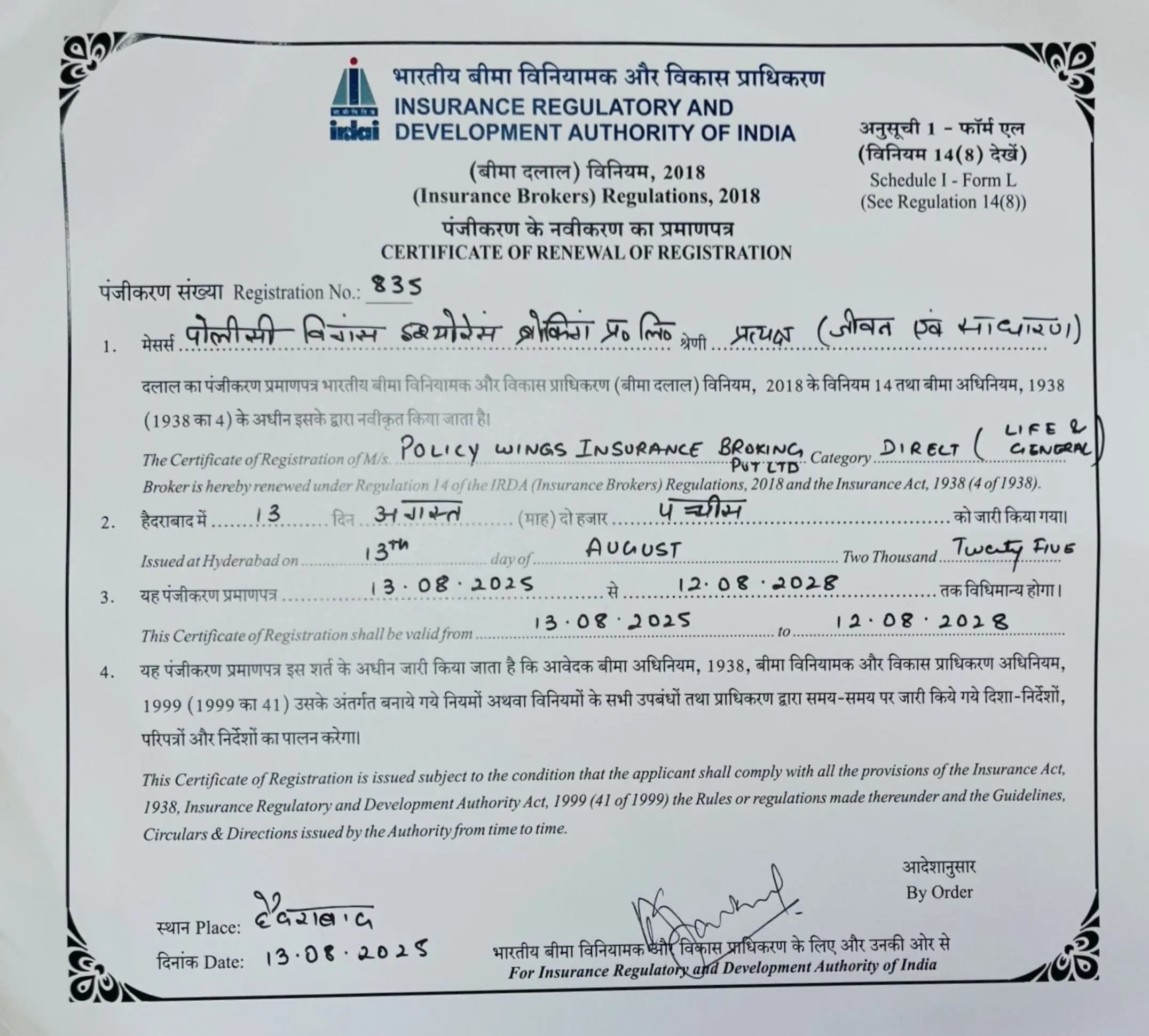Health Insurance for surgery
Health Insurance For Surgery
A human body is prone to illnesses and several of them have only surgical intervention as a remedy. A surgery, however, minor it may be, involves a certain amount of risk which is comparatively higher than any other form of treatment. Some surgeries require hospitalisation for a few hours, while some require a few days, depending on the type of surgery that you have undergone and your health condition and response towards treatments and therapies.
Although medical and technological advancements have improved surgical procedures to a significant extent, the medical inflation factors have raised the costs too. A few days of hospitalisation due to any surgery is enough to deplete a considerable part of your hard-earned money.
A competent surgery insurance cover is enough to save your day under such circumstances.
What is surgery insurance?
Surgery or operation insurance involves a surgical intervention to cure any ailment. Any surgery is a critical medical process and proves to be essential to offer remedies for certain health conditions.
Surgery insurance is a special variant of a health insurance plan that offers competent comprehensive coverage for surgery costs. It acts as a financial protection cover for certain predetermined surgical procedures.
This list of surgeries covered by a surgery insurance plan differs from one insurance company to another. However, each of them ensures you access to the best medical facilities available to complete the necessary surgical procedure.
A competent surgery health insurance cover retains your peace of mind by offering assurance that you receive the best possible medical facilities without worrying about finances.
List of surgeries covered under operation insurance plans
Currently, the insurance market has several types of surgery insurance policies. Not all of them offer coverage for every sort of surgery, but there is a common trend. After careful research, we have encountered some common surgery procedures usually covered by surgery health insurance policies.
Some of these surgeries are daycare procedures, implying that they require less than 24 hours of hospitalisation, while some others require hospitalisation for a few days for you to recover.
Such common surgery procedures include the following:
1. Cataract surgery
Several health insurance providers offer special surgery insurance for cataract surgery. This is a daycare procedure and requires hospitalisation for a few hours. However, there is a probability that there may be pre-defined sub-limits on the coverage limit. This implies that the insurance provider might pay only up to a certain limit of the costs incurred. Moreover, there may be a waiting period of at least 1-2 years for most such insurances. You have to clarify all the details beforehand.
2. Heart surgery
There are special insurance policies that exclusively focus on surgical remedies for the heart. If you need to undergo any sort of heart surgery, you can get your costs covered under such plans. The specific terms and conditions may vary from one insurer to another. You have to clarify and compare different such plans to know which one suits your requirements the best.
3. Knee replacement surgery
This form of therapy has gained rapid popularity and is very common, especially in recent times. While some insurers may agree to cover the entire cost of the surgery others only agree to pay a part of it, depending on the terms of the chosen plan. Depending on the terms of your chosen insurer, the waiting period may vary anywhere between 2 and 4 years in the case of PEDs.
4. Kidney stone removal
Removing kidney stones has become a minor affair in light of today’s medical and technological advancements. Most doctors prefer the microsurgery technique, involving minimal incision. This makes the recovery process faster too. However, you must note that surgery, however minor it may be, must be involved, to get this insurance coverage. Only medicinal remedies without any surgical intervention will not entertain your claim under this policy.
5. Bypass surgery
Bypass surgery is a major heart surgery. There are specialised insurance plans that simply focus on heart bypass surgery only. Your insurance for heart surgery will also cover this cost. However, you can avail of a separate plan for bypass surgery if you feel the requirement. However, the terms and conditions may vary from one insurer to another. You must be aware of all the inherent conditions before you proceed to purchase one.
6. Appendix surgery
Appendicitis surgery is usually covered by most surgery insurance plans. However, you must clarify all the inclusions and exclusions beforehand to avoid any misunderstandings during claim settlement. The surgery involves a small incision and a rapid removal of the appendix. Leaving the affected appendicitis untreated may lead to grave suffering in future. So, if the need arises it is best to get it removed under expert medical guidance and facilities at the earliest.
7. Liver transplant surgery
Any organ transplant is a serious and major surgical procedure and liver transplant is no exception. Several insurance providers offer coverage for organ donor costs. However, liver transplant surgery insurance will bear all the associated costs of the surgery and not only the organ donor expenses, depending on the terms and conditions of your chosen policy.
It includes critical liver screening, pre-hospitalisation costs, hospitalisation costs, surgery expenses, post-surgery costs, recovery expenses, and post-hospitalisation costs. We can well understand that this is quite an expensive affair. Insurance coverage protection can save your day under such critical circumstances.
8. Brain surgery
Any surgical intervention on the brain is considered to be critical and gets insurance coverage. The brain is considered to be one of the most vital and major body parts. Any surgery on such body organs is a serious and expensive affair. Apart from critical illness insurance policies, there are specific surgery insurance plans that cover brain surgery costs. Befitting surgery insurance policies will cover pre- and post-hospitalisation cover, hospitalisation charges, ICU expenses, surgery costs, and recovery costs.
9. Kidney transplant surgery
As mentioned earlier, any sort of transplantation is a major surgical procedure and involves a considerable amount of risk and money. Kidney transplant costs are usually covered by critical illness policies and maintain a waiting period of 90 days under standard circumstances. Any standard health plan for patients with kidney transplants usually covers the costs of the recipients. It competently handles the pre- and post-hospitalisation cover, hospitalisation expenses, surgery costs, organ donor costs, ICU charges, ambulance cover, recovery expenses, etc., depending on the terms of the concerned plan.
10. Prostate cancer surgery
A prostate is a tiny walnut-looking male gland that leaves the female urethra post-ejaculation, generating seminal liquid and eventually nourishing and transporting semen. However, this gland is very prone to cancer that requires surgical intervention for treatment. There are competent surgery health policies that cover the costs of prostate cancer surgery, including screening costs, treatment costs, surgery charges, pre- and post-hospitalisation cover, etc.
11. Heart transplant surgery
Heart transplant surgery is covered under specific cardiac plans, critical illness insurance, and also surgery policies, if surgical intervention is involved. Multiple insurance providers offer organ transplant expenses and it is the same for heart transplantation too. Under competent insurance providers, you can easily avail of both cashless as well as reimbursement facilities for claim settlement.
12. Bariatric surgery
If you meet the specific requirements and eligibility criteria of your insurance provider, your costs for bariatric surgery will receive insurance coverage. This obesity-treating surgery is a considerably expensive affair and may cost between INR 2 lakhs and INR 6 lakhs. However, it may differ depending on the circumstances and several other contributing factors.
Some of the popular types of bariatric surgery include sleeve gastrectomy, mini gastric bypass, metabolic surgery, adjustable gastric banding, reduced port surgery, the Roux-en-Y gastric bypass, etc.
The criteria for getting insurance coverage for bariatric surgery include:
○ Attaining 18 years of age while undergoing the surgical procedure
○ The BMI must be 40 or above
○ BMI is 35 but you suffer(ed) from stroke, heart ailments, diabetes, etc.
○ Proper medical advice suggesting the surgical intervention as a remedy by at least one registered medical practitioner
13. Breast cancer surgery
Fixed-benefit plans like critical illness coverage policies cover breast cancer surgery costs. Regular health policies do not cover breast cancer surgery costs. However, you may add a critical illness rider to enhance the coverage. Surgery insurance plans also cover breast cancer surgery costs. The standard waiting period is 2 years. However, it may vary depending on the terms of your chosen insurance.
14. Aorta graft surgery
This is also covered under critical illness insurance plans. Depending on the stage of the ailment, the method the surgery is decided. It may take 5 hours or even more. The average cost may range between 4.5 lakhs and 6 lakhs. However, it may vary depending on the medical services you require and receive depending on your health condition. Competent surgery insurance covers aorta graft surgery costs.
15. Lung transplant surgery
Lung transplant or pulmonary transplantation becomes essential when the existing lung fails to purify deoxygenated blood. On the availability of suitable donors, the doctors may seek lung transplantation, where the existing lungs get replaced by donor lungs. This is a serious medical procedure and quite expensive too. If you have a befitting surgery insurance plan, you can get insurance coverage for the same including the organ donor costs.
16. Robotic surgery
As per the IRDAI norms, Indian health policies mandatorily offer coverage for robotic surgeries, including hospitalisation costs, surgery costs, nursing charges, doctors’ fees, ICU cover, pre- and post-hospitalisation costs, etc.
17. Hip replacement surgery
Most insurance providers offer befitting plans that cover hip replacement surgery costs. If the hip gets severely damaged due to an accident, you may require an artificial prosthetic hip implant. This is termed a hip prosthesis. Depending on the current health condition, you may need either a total hip replacement or a partial one. Surgery insurance will cover the costs incurred in the process. However, you may need to serve a waiting period of 1-2 years, depending on the terms of the plan you have chosen.
18. Deep brain stimulation surgery
This sort of brain surgery also termed as DBS in short is essential for patients suffering from Parkinson’s disease. A tiny battery-operated medical device termed an implantable pulse generator is inserted for smooth electrical stimulation in specific brain areas. Since such implantation involves surgical intervention, surgery insurance covers DBS.
19. LASIK eye surgery
Heavily myopic individuals may opt for this surgery and all insurance plans cover this. However, it will not be covered if the refractive power of the affected individual remains below 7.5 diopters. If you still opt for LASIK, it becomes optional and therefore you do not get insurance coverage. The LASIK may cost between INR 20000 and INR 30000 on average.
Inclusions of surgery insurance plans
Some standard inclusions of a surgery insurance plan include the following:
1. Screening
2. Pre-hospitalisation covers for a specific period
3. Ambulance charges
4. Hospitalisation expenses
5. Surgery costs
6. Doctors’ charges
7. Nurses charge
8. ICU costs
9. Recovery expenses
10 .Post-hospitalisation charges up to a specified tenure, etc.
Exclusions of surgery insurance plans
Although the list of inclusions may vary from one insurer to another, the Insurance Development Authority of India has standardised certain common exclusions that are equally applicable to every insurance plan. These common exclusions include:
1. A genetic disorder or congenital issue:
This implies any health issue present in any individual since birth. It can be further classified as external congenital issues like excess skin formation outside or internal congenital issues like defective or weak hearts since birth, etc. No health plan covers such issues.
2. Cosmetic surgery:
Cosmetic surgeries including Botox, lip and breast augmentation, facelifts, rhinoplasty, etc. are methods to enhance the existing physical beauty. These are not indispensable and doing without them does not hamper the daily life activities of any individual. Therefore, these surgical procedures are not covered by any health insurance plans.
3. Health issues arising due to overconsumption of drugs, alcohol or other similarly intoxicating substances:
You cannot deny the fact that regular smokers and alcohol consumers carry a comparatively higher risk of several lifestyle diseases which can become quite serious in the long run like mouth or lung cancer, bronchitis, liver issues, etc. No health plan covers the cost of such treatments.
4. Infertility and IVF treatments:
Any infertility treatment or IVF procedures are planned events and involve a significantly higher sum. So, no such treatment procedures get covered under surgical insurance plans.
5. Pregnancy treatments:
Surgical health insurance plans do not offer coverage for any sort of treatment for pregnancy-related complications.
6. Voluntary abortion:
Voluntary abortion is a matter of choice and our country has certain specific rules regarding this. So, it does not get covered under surgery insurance plans.
7. Pre-existing ailments:
Every health insurance coverage plan maintains a list of PEDs that will not be covered before a certain period. Therefore, if you undergo any surgery for any of those ailments it will not get covered under a standard surgery insurance cover.
8. Self-inflicted injury:
Health plans do not cover any self-inflicted injury leading to suicide or attempted suicide.
9. Transmitted disease:
Treatment costs for any venereal or transmitted diseases like HIV/AIDS do not get covered under surgery health plans.
10. Permanent exclusions:
Some of the permanent exclusions of any surgical health cover include treatment and surgery costs for treating injuries caused in any war or riot-like situation, due to involvement in any defence activities or adventurous activities.
Benefits of buying health insurance for surgery
Some of the most highlighting benefits of obtaining health insurance for surgery include:
1. Coverage for specific surgical procedures
2. Pre-hospitalisation cover
3. Hospitalisation cover
4. Post-hospitalisation cover
5. In-patient care costs
6. Daycare treatment costs
7. Organ donor coverage
8. Cost of obtaining a second medical opinion
9. Annual health check-up facility
10. No Claim Bonus availability for raising no claims
11. Air ambulance cover within the country
12. Unlimited room rent coverage
13. Ensures peace of mind and a lot more.
So, opting for a health insurance for surgery is not just a financial decision but an emotional one to ensure best in class treatment opportunities for yourself and your loved ones without havign to stress about money.
Surgery insurance plan eligibility criteria
Some of the basic eligibility criteria that you need to meet for purchasing surgery health insurance coverage include:
1. The policyholder must be at least 18 years of age and usually the maximum age limit is 65 years. However, it may vary from one insurance company to another.
2. You might require health check-ups at your own cost for certain specific ailments before policy issuance
3. The waiting periods for different ailments are different for different insurers and you will receive the coverage accordingly.
How to buy health insurance for surgery Online?
Buying a befitting surgery insurance plan online is very simple, quick, and paperless. You can do it anytime at your convenience. You simply need to follow these steps:
1. Make a thorough research to know which surgery insurance will work best for you
2. Once the choice is finalised, visit the official website of your chosen insurer or download their designated app
3. Search for the specific surgery insurance
4. Enter all the relevant details as required
5. Click on “Submit”
6. Pay the relevant premium amount using any online mode
7. Click “buy”
8. You will receive the policy documents at your registered email address shortly.
Things to keep in mind while buying a surgery insurance plan
Some of the most critical factors that you need to consider before buying health insurance for surgery include:
1. Age:
You must meet the relevant age criteria per your insurer’s requirement to purchase surgery health insurance.
2. Correct balance of coverage and premium:
A thorough and wise analysis and homework are essential to know which plan suits you best offering optimum coverage and the lowest possible price.
3. Waiting period:
The waiting period for different ailments varies from one insurer to another. You must be aware of this specific clause for your chosen plan for smooth claim settlement. This implies that no claim will be settled for those specific ailments before that period is over.
4. Cashless hospitalisation:
The more number of network hospitals your insurer maintains, the better chances you have to avail of cashless hospitalisation facilities.
5. Maternity coverage:
Most insurances do not cover maternity insurance plans. However, if you need one you must customise your search accordingly.
6. No Claim Bonus:
Some health insurance providers offer a No Claim Bonus for each claim-free year. This eventually raises your sum insured amount. However, it may be available in other reward forms too, depending on the approach of your insurance provider.
7. Preventive health check-up benefit:
You should opt for an insurer that offers preventive health check-up benefits annually. It helps in early detection of any ailment and close monitoring of your health.
8. Co-payment clause:
You need to share a part of your total claim with your insurer. It is defined by a specific percentage. The policy document mentions this. The higher the co-payment percentage, the lower the premium and vice versa.
9. Claim process:
You must ensure that the claim process of your chosen insurer is smooth and maintains a smooth claim settlement ratio.
10. Inclusions and exclusions:
Not all surgery insurance plans suit every type of surgery. You must make a clear analysis beforehand and make your choice accordingly.
Tax benefits
Since surgery insurance is a type of health insurance, you can avail of tax benefits under Section 80D of the IT Act. This tabular representation will clarify the matter:
| POLICY FOR | DEDUCTION FOR SELF AND FAMILY | DEDUCTION FOR PARENTS |
| Self and family all below 60 years | INR 25000 | – |
| Self and family along with parents all being non-senior citizens | INR 25000 | INR 25000 |
| Self and family (below 60 years) + parents (senior citizens) | INR 25000 | INR 50000 |
| Self+family+parents all are senior citizens | INR 50000 | INR 50000 |
| Non-senior citizen members of the HUF | INR 25000 | INR 25000 |
| Members of HUF with one senior citizen member | INR 50000 | INR 50000 |
Key factors to consider while purchasing critical illness insurance for surgery
Since surgery health insurance is a contract between you and the insurance company, you must be very critical and wise while making your selection. Some of the most significant factors that you need to keep in mind while buying critical illness insurance for surgery include:
1. Inclusions and exclusions:
Every type of insurance maintains a clear set of inclusions and exclusions. You must have a clear understanding of all these inclusions and exclusions for a smooth claim settlement.
2. Selecting the right insurer:
You must choose your insurer only after careful and thorough research and homework. This is essential as the market is loaded with innumerable insurance providers and thousands of health plans. Making the right choice might prove to be overwhelming and confusing without proper study.
3. Waiting period:
Every health plan comes with a specific waiting period clause for certain specific ailments. This means you cannot raise any claim during the waiting period for those pre-defined illnesses.
4. Sum insured and the premium amount:
You have to ensure that the premium amount remains within your budget and maintaining befitting critical illness insurance for surgery does not seem financially burdensome. Clarify the coverage span and the premium details beforehand. You can also use the premium calculator very easily available online.
5. Day care procedures:
Your surgery plan must ideally cover day care procedures i.e., surgeries that require less than 24 hours of hospitalisation. Cataract surgery is an ideal example in this context.
6. Specific ailments covered:
Not every surgery plan is suitable for all types of surgeries. You must ensure what are the specific types of surgeries that your surgery policy covers for.
7. Co-payment:
Most health plans come with a co-payment clause, meaning you have to share a pre-determined percentage with your insurer during claim settlement. The co-payment is inversely proportional to the premium payable amount.
8. Network hospitals:
You must ensure that your insurance provider maintains an enriched network of listed hospitals. This will confirm the easy availability of cashless treatment facilities across the country.
9. Additional benefits:
Several insurers offer additional benefits like NCB, annual health check-up facilities, etc. You can clarify with your respective insurance provider if there are any such benefits offered for your plan.
Frequently Asked Questions
If the risk involvement remains too high with enormous financial involvement and for a considerable time, the insurance providers tend to back out from settling claims.
Depending on the terms and conditions of the concerned insurance provider and the chosen insurance plan, certain health insurance plans offer coverage for AYUSH treatments, including, homoeopathy, Ayurveda, Unani, etc.
Any voluntary cosmetic surgery procedures like liposuction, facelift, implants, Botox, etc. are not covered by insurance policies.
Surgery insurance implies insurance coverage for those health remedies that require surgical intervention. It is also termed operation insurance.
Most surgery health plans include post-hospitalisation expenses for up to 45-90 days after the hospital discharge date. It remains mentioned in the policy details.
The four commonest forms of surgeries include treatment of wounds, extirpative surgery, reconstructive surgical procedure and transplantation.
Leading Health Insurance Companies





Latest Blogs
Introduction While buying or renewing car insurance, you would surely come across two very common terms: Zero Depreciation and...
Introduction In India, getting insurance for your car is non-negotiable. With so many plans and so many add-ons available, it...
Introduction Everyone deserves healthcare but sadly, with the medical expenses rising so fast in India, not everyone can afford...
Introduction Do you think that buying life insurance means having to go through complicated policies and paperwork and paying...
Introduction You don’t buy a car insurance just fulfil a legal requirement. The repair costs have really increased, spare...
Introduction You can’t predict life but it’s always possible to secure the financial future of your family with life...
Introduction You have waited so long to finally purchase that car, saved for it and checked all those reviews....
Introduction Upon buying insurance, you will notice different short forms in your policy documents that might confuse you. One...









